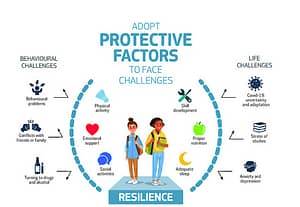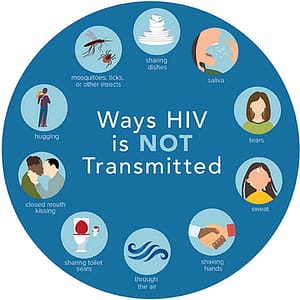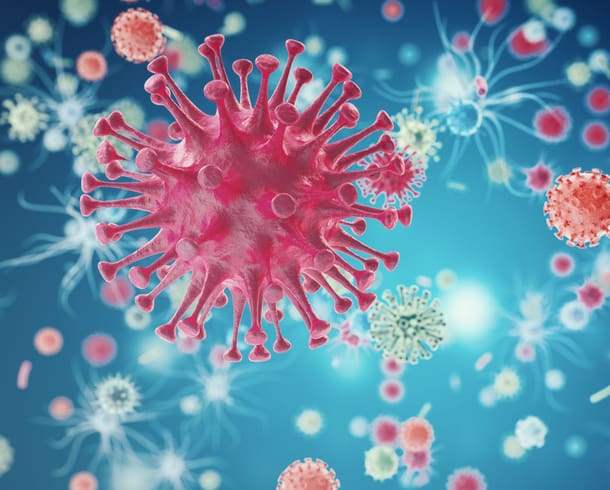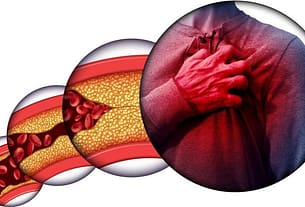When a person contracts HIV and does not receive treatment, the infection progresses through three stages.
For anyone who may have been exposed to HIV, it is important to talk with a healthcare professional for advice and ask them about a preventive therapy called postexposure prophylaxis (PEP)
People at risk of exposure to HIV can take preexposure prophylaxis (PrEP) regularly to prevent the infection from taking hold, even if exposure occurs.
Stage 1: Acute HIV infection
After a person comes into contact with HIV, the virus replicates quickly, and the blood contains high levels of the virus. At this time, the virus can easily transmit to others through:
- blood
- semen and preseminal fluid
- rectal fluid
- vaginal fluid
- breast milk
Within 2–4 weeks of exposure to the virus, some people develop a nonspecific syndrome with a fever and other flu-like symptoms. This may last for several days or weeks.
Not everyone experiences these symptoms, though. If a person does not get tested, it is possible for HIV to progress without any indication that it’s in the body.
The flu-like symptoms of a stage 1 HIV infection may include:
- fever
- muscle or joint pain
- tiredness
- night sweats
- skin rashes
- ulcers in the mouth
- sore throat
- swollen glands
- nausea or vomiting
These symptoms are collectively known as a seroconversion illness. They represent the body’s natural response to an infection as it attempts to kill off the virus. However, the human body cannot completely remove HIV once it is present.
At this stage, the virus replicates using the body’s CD4 T cells and spreads throughout the body. In doing so, it destroys CD4 T cells.
Eventually, this process stabilizes. The immune system reduces the number of viral particles, and levels of CD4 T cells may rise. However, the number of these cells may not return to its original level.
Stage 2: Chronic HIV infection
After the acute stage has ended, and if the person has not received treatment, the virus remains active. It reproduces at very low levels but continues to damage immune cells.
At this stage, there are usually no symptoms or very mild ones. This is why doctors sometimes call stage 2 “asymptomatic HIV infection” or “clinical latency.” The virus can still be transmitted to others during this stage, even if it causes no symptoms.
Without treatment, this stage can last 10 years or more before the person develops stage 3 HIV.
However, modern antiretroviral medications can stop the infection from progressing. These drugs greatly reduce the amount of HIV in the body, called the viral load, to very low levels.
When the viral load is so low that tests cannot detect it, HIV can no longer damage the immune system or be transmitted to other people. Some people refer to this as “undetectable equals untransmittable” or “U=U.”
A person with stage 2 HIV who takes effective antiretroviral therapy may never develop stage 3 HIV.
Stage 3 HIV
Stage 3 HIV, also known as AIDS, is the most advanced stage. It occurs when the immune system is damaged to the extent that it can no longer fight off infections.
Taking antiretroviral drugs keeps the immune system strong enough to prevent HIV from progressing to this stage.
Without treatment, the viral load continues to increase and the CD4 cell count continues to drop. A person receives a diagnosis of stage 3 HIV if their CD4 cell count drops under 200 cells per cubic milliliter, or if they develop an opportunistic infection.
Symptoms at this stage vary greatly because they tend to stem from specific opportunistic infections.
Symptoms of stage 3 HIV can include:
- night sweats
- fever
- persistent cough
- problems affecting the skin, mouth, or both
- regular infections
- chronic diarrhea
- weight loss
Due to modern treatments, opportunistic infections are increasingly less common. There are many types, but some of the most common opportunistic infections in the United States are:
- herpes
- salmonella
- candidiasis
- toxoplasmosis
People can recover from serious HIV-related infections and diseases and manage HIV with treatment. Treatments for opportunistic infections include antivirals, antibiotics, and antifungals.
Left untreated, HIV infection goes through the following stages:
1. Seroconversion illness
Some people experience a short illness soon after they contract HIV. This is known as seroconversion illness or primary or acute HIV infection.
In some people, seroconversion illness is so mild that it passes without being noticed. Some people mistake it for the flu, but for others it’s more severe and they may need to see a doctor.
Seroconversion is the period when someone with HIV is at their most infectious.
2. The asymptomatic stage of HIV
Once seroconversion is over, most people feel fine and don’t experience any symptoms. This is often called the asymptomatic stage and it can last for several years.
Though you might feel well at this stage, the virus is active, infecting new cells, making copies of itself and damaging your immune system’s ability to fight illness.
3. Symptomatic HIV
The longer you live with HIV without treatment, the greater your risk of developing infections that your weakened immune system can’t fight: certain cancers, as well as the direct effects of
4. Late-stage HIV
If HIV has a chance to cause a lot of damage to your immune system, you may become ill from certain serious opportunistic infections and cancers. These illnesses are also known as AIDS-defining.
AIDS-defining illnesses:
- cancer
- tuberculosis (TB)
- pneumonia
If diagnosed promptly and go onto treatment straightaway, most people living with HIV never experience late-stage HIV. Staying healthy is key to living well with HIV, including exercising regularly, sleeping well and eating well, stopping smoking, and looking after your mental wellbeing.
How to prevent HIV from progressing
The most effective way to keep HIV from progressing is to take antiretroviral medication as soon as possible and to do so consistently as a doctor prescribes.
Antiretroviral therapy keeps the immune system healthy. It also reduces the risk of transmitting HIV to virtually zero.
The sooner a person receives a diagnosis, the sooner they can begin treatment. Early treatment can improve the person’s outlook and lower the risk of the virus transmitting to others.
Antiretroviral therapy
Antiretroviral therapy keeps the immune system healthy and prevents the virus from transmitting. It benefits a person regardless of the stage of HIV.
Antiretroviral therapy:
- suppresses viral activity
- increases the person’s immunity and life span
- reduces the chance of the virus transmitting
Taking antiretroviral therapy reduces the amount of HIV in the blood to very low or undetectable levels. In most people taking antiretroviral drugs, the virus is under control within 6 months.
Once the viral load is undetectable, there is virtually no risk of transmitting HIV to other people.
A doctor may adapt the combination of drugs for the person. Taking the medication consistently as prescribed makes it more effective. It also reduces the chances of the virus developing resistance to the treatment.
PEP
If a person was recently exposed to HIV, they can prevent it from taking hold using PEP. This is an emergency option.
PEP is most effective when a person takes it as soon as they suspect exposure to HIV and within 72 hours of exposure. When a person does this, PEP can prevent HIV.
Lifestyle factors

Certain lifestyle factors can play a role in the progression of HIV. A person can adopt strategies to boost their immune system, including:
- Avoiding infections: Take steps to protect against infections and illnesses, such as getting regular vaccinations if a doctor recommends it.
- Reducing stress: Stress weakens the immune system. It increases the risk of developing other illnesses and opportunistic infections.
- Using condoms during sexual intercourse: Condoms protect people with HIV from other sexually transmitted infections that can further weaken their immune system.
- Exercising regularly: Regular physical activity brings many benefits, including a lower risk of heart disease, increased energy, improved circulation and lung capacity, better sleep, and less stress.
- Eating a balanced diet: Maintaining a nutritious, balanced diet with a low alcohol intake helps boost the immune system and ward off infections. Nutritious food can also help HIV treatment work properly.
- Quitting smoking: People with HIV who smoke are more likely to develop infections, such as candidiasis and pneumonia, and illnesses, such as certain cancers, heart disease, and chronic obstructive pulmonary disease (COPD).
Other factors that affect progression
Some factors are not under a person’s control. Additional factors that can play a role in HIV progression include:
- age
- genetics
- HIV subtype
- overall health before the infection
- presence of other infections
How is HIV transmitted?

- blood
- semen (including pre-cum)
- vaginal fluid
- anal mucus
- breast milk.
People can get HIV through:
- vaginal/frontal and anal sex without a condom
- sharing drug injecting equipment
- sharing sex toys
- mother-to-child transmission during pregnancy
- coming into contact with contaminated blood.
Most activities pose no risk of getting or passing on HIV.
HIV cannot be passed on by:
- kissing
- hugging
- shaking hands
- sharing space with someone
- sharing a toilet
- sharing household items such as cups, plates, cutlery, or bed linen
- any other general social contact.
How long can HIV survive outside the body?

Similarly, the risk of passing on HIV to someone else if you have a detectable viral load and cut yourself is also very low. Wash away any blood with soap and hot water and cover the wound with a sticking plaster or dressing.
Some people may develop an acute HIV infection that causes flu-like symptoms within 2–4 weeks of exposure. Symptoms may include:
- fever
- fatigue
- mouth ulcers
- swollen glands
Some people do not develop noticeable symptoms.
How long can you have the virus that causes AIDS without knowing?
A person can potentially have an asymptomatic HIV infection without knowing if they do not get tested. In some cases, this stage can last for 10 years.
A person may not discover they have an HIV infection until their immune system cannot fight off opportunistic infections, such as salmonella or herpes.
If HIV has a chance to cause a lot of damage to your immune system, you may become ill from certain serious opportunistic infections and cancers. These illnesses are also known as AIDS-defining.
AIDS-defining illnesses:
- cancer
- tuberculosis (TB)
- pneumonia
If diagnosed promptly and go onto treatment straightaway, most people living with HIV never experience late-stage HIV. Staying healthy is key to living well with HIV, including exercising regularly, sleeping well and eating well, stopping smoking, and looking after your mental wellbeing.
Outlook
For a person with HIV, their outlook largely depends on whether they have consistent access to treatment and are taking it as prescribed.
If a person with HIV receives consistent antiretroviral therapy before the infection advances, they can live a long, healthy life, with a life expectancy comparable to that of someone without HIV.
Without treatment, a person may develop stage 3 HIV within 2–15 years after contracting the virus. The life expectancy after a stage 3 HIV diagnosis is 3 years.
However, with effective medication, many people never develop stage 3 HIV. The likelihood of opportunistic infections is much lower than it was in the past.





